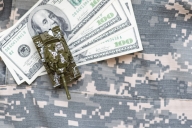You have /5 articles left.
Sign up for a free account or log in.
Saturday night, Texas A&M quarterback Johnny Manziel, known as “Johnny Football,” became the first freshman in history to win the Heisman Trophy.
Following the win, as reported by ESPN.com, “Texas A&M isn't wasting any time marketing itself.”
That marketing includes a Times Square billboard, as well as full page ads in the New York Times, USA Today, and other regional papers. This ad buy alone likely reaches half a million dollars, given that a Times Square billboard for 2001 Heisman hopeful Joey Harrington cost $250,000 all by itself more than 10 years ago and full-page ads in the Times run at least $50,000.
Joey Harrington’s billboard was paid for by University of Oregon “boosters,” but the Johnny Football post-victory trumpet blowing is a “collaboration between the Aggies athletic department and the university at large.”
A pre-Heisman campaign (like the Harrington billboard) is de rigueur, a way to reach the voting constituency, but given that Manziel has already won the award, Texas A&M’s goals are, in the words of the university’s vice president of marketing and communications to build a “national brand.”
My tone probably betrays my skepticism that this is money well-spent, though I also must admit that I don’t know enough about the university development business to declare that Texas A&M’s goal of a “decent return” on investment is pure fantasy. I’m willing to be turned around on this if someone smarter or better informed than me has the argument and the facts to back it up.
So I’m going to ask some questions.
1. What are the possible “returns” of this kind of thing? Baylor University claims that Robert Griffin III’s Heisman’s win last year was worth, “$250 million in extra donations, increased ticket sales, licensing fees, sponsorship deals, an expanded deal with Fox Sports Southwest, and higher corn dog sales.” Assuming this number isn’t pulled out of thin air, does any of this money ultimately make its way to the academic mission of the university. Does the glow of success from the football team also loosen purses and wallets when it comes to donations to the academic mission? If anyone has links or citations, that would be much appreciated.
2. What benefit does Texas A&M receive from becoming a “national brand?” Do they not already receive more applications that they have room for in their freshman class? Is a university de facto better off if they are a "national brand" when it comes to athletics (or even academics)?
3. Isn’t there some kind of law/rule/guidelines that money for this kind of thing has to come from athletic department money and not other university sources?
4. Why does the NCAA get to produce hours and hours of programming surrounding this single athletic award (earning revenue all the way), and yet its winner isn’t allowed to capitalize monetarily on it to the tune of even one dime? Manziel is not even permitted to the use of his own likeness. Isn’t there some kind of anti-trust lawsuit to be had?
An inquiring mind (mine) wants to know.
--
You could tweet me information also because I do that sometimes.





